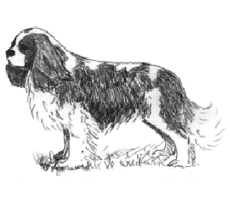Cavalier King Charles Spaniel
General Information - Cavalier King Charles Spaniel

Group:
Toy
Size:
small
Lifespan:
9 - 14 years
Exercise:
moderate
Grooming:
moderate
Trainability:
high
Watchdog ability:
moderate
Protection ability:
very low
Area of Origin:
England
Date of Origin:
1600s
Other Names:
none
Original Function:
flushing small birds,
lapdog
History
Developed from a cross between the King Charles and a Cocker Spaniel, the Cavalier differs greatly from its forebears. Its breeders were trying to reproduce a toy dog similar to those seen in portraits from the time of England's Charles II, who was said to dote on these small dogs. In the 1920's the American, Roswell Eldridge, offered prize money during a Cruft's Dog Show in London, to any person exhibiting King Charles Spaniels with long noses. He was looking for dogs similar to those appearing in Van Dyck's paintings of King Charles II and his spaniels. By the 1940's these dogs were classified as a separate breed and were given the prefix Cavalier, to differentiate them from their forebears.
Temperament
The Cavalier in many ways fits the bill as an ideal house pet. It is sweet, gentle, playful, willing to please, affectionate and quiet. It is amiable toward other dogs, pets and strangers. Outdoors, its spaniel heritage kicks in, and it loves to explore, sniff and chase. The Cavalier King Charles spaniel is an eager, affectionate tail-wagger. Lively, outgoing and sporty, these fearless lively little dogs want to please. They are intelligent enough to understand what you want and therefore are usually easy to train and respond well to gentle obedience training.
Upkeep
The Cavalier needs a fair amount of exercise every day, either in the form of a moderate walk on leash or a romp in a safe area. This is not a breed that should live outdoors. Its long coat needs brushing every other day.
Cavalier King Charles Spaniel
A breed standard is the guideline which describes the ideal characteristics, temperament, and appearance of a breed and ensures that the breed is fit for function with soundness essential. Breeders and judges should at all times be careful to avoid obvious conditions and exaggerations, as well as being mindful of features which could be detrimental in any way to the health, welfare or soundness of this breed.
Breed Standard - Cavalier King Charles Spaniel
 General Appearance:
General Appearance: Active, graceful and well balanced, with gentle expression.
Characteristics: Sporting, affectionate, absolutely fearless.
Temperament: Gay, friendly, non:aggressive; no tendency to nervousness.
Head and Skull: Skull almost flat between ears. Stop shallow. Length from base of stop to tip of nose about 3.8 cms (1½ ins). Nostrils black and well developed without flesh marks, muzzle well tapered. Lips well developed but not pendulous. Face well filled below eyes. Any tendency to snipiness undesirable.
Eyes: Large, dark, round but not prominent; spaced well apart.
Ears: Long, set high, with plenty of feather.
Mouth: Jaws strong, with a perfect, regular and complete scissor bite, i.e. upper teeth closely overlapping lower teeth and set square to the jaws.
Neck: Moderate length, slightly arched.
Forequarters: Chest moderate, shoulders well laid back; straight legs moderately boned.
Body: Short:coupled with good spring of rib. Level back.
Hindquarters: Legs with moderate bone; well turned stifle - no tendency to cowhocks or sickle:hocks.
Feet: Compact, cushioned and well feathered.
Tail: Length of tail in balance with body, well set on, carried happily but never much above the level of the back. Docking optional. If docked, no more than one:third to be removed.
Gait/movement: Free:moving and elegant in action, plenty of drive from behind. Forelegs and hindlegs move parallel when viewed from in front and behind.
Coat: Long, silky, free from curl. Slight wave permissible. Plenty of feathering. Totally free from trimming.
Colour: Recognised colours are:
- Black and Tan: raven black with tan markings above the eyes, on cheeks, inside ears, on chest and legs and underside of tail. Tan should be bright. White marks undesirable.
- Ruby: whole coloured rich red. White markings undesirable.
- Blenheim: rich chestnut markings well broken up, on pearly white ground. Markings evenly divided on head, leaving room between ears for much valued lozenge mark or spot (a unique characteristic of the breed)
- TriColour: black and white well spaced, broken up, with tan markings over eyes, cheeks, inside ears, inside legs, and on underside of tail.
Any other colour or combination of colours highly undesirable.
Size: Weight - 5.4-8.2 kgs (12-18 lbs). A small, well balanced dog well within these weights desirable.
Faults: Any departure from the foregoing points should be considered a fault and the seriousness with which the fault should be regarded should be in exact proportion to its degree and its effect upon the health and welfare of the dog.
Note: Male animals should have two apparently normal testicles fully descended into the scrotum.
DNZ No 108
Copyright Dogs New Zealand
28 Jul 2006
Any departure from the foregoing points should be considered a fault and the seriousness with which the fault should be regarded should be in exact proportion to its degree and its effect upon the health and welfare of the dog and on the dog’s ability to perform its traditional work.




